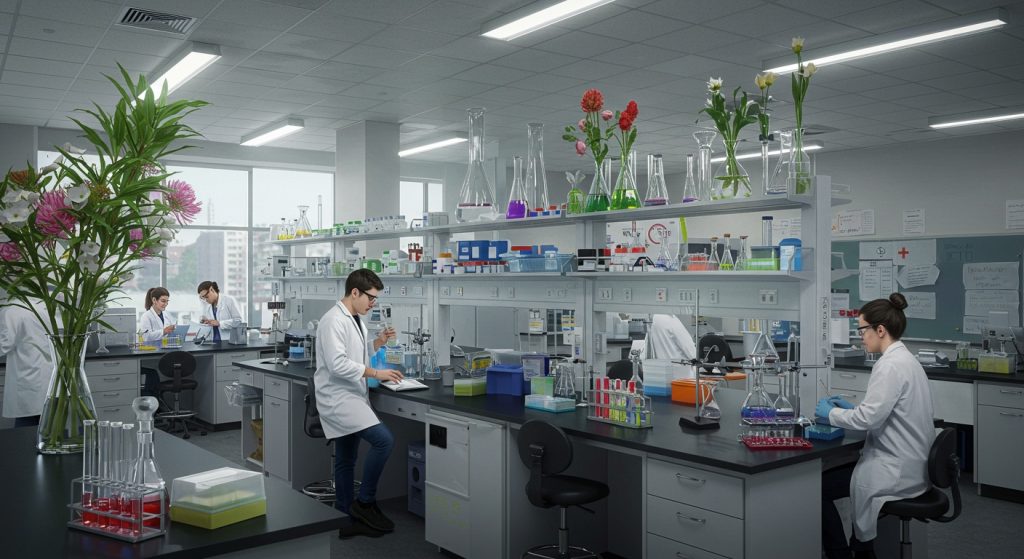The burgeoning biotechnology sector, propelling innovations from advanced gene therapies like those for sickle cell disease to sustainable biomanufacturing, offers unparalleled scientific frontiers for PhD candidates. But, the intensive laboratory work, specialized equipment. Extensive research required necessitate substantial investment. Navigating the landscape of funding options for a biotechnology PhD is therefore paramount, transforming a potential financial barrier into a strategic advantage. Securing support through prestigious federal fellowships, competitive university assistantships, or targeted industry grants from leading biopharma companies empowers future scientists to dedicate themselves fully to high-impact research, accelerating breakthroughs that shape global health and environmental solutions.

Understanding the Landscape of Biotechnology PhDs and Why Funding Matters
Embarking on a Biotechnology PhD is an ambitious and incredibly rewarding journey, placing you at the forefront of scientific innovation. From developing groundbreaking therapies and diagnostics to engineering sustainable solutions, biotechnology offers a vast landscape for impact. But, pursuing a doctorate is a significant time commitment, typically ranging from four to seven years. It often involves foregoing traditional employment income. This is where comprehensive funding becomes not just a convenience. A critical necessity. Adequate financial support allows you to focus solely on your research, coursework. Professional development without the added stress of financial insecurity. Understanding the diverse funding options for biotechnology PhD candidates is the first step toward securing your future and maximizing your doctoral experience.
Without proper funding, students might face challenges such as:
- Increased stress and anxiety, potentially impacting research productivity.
- Taking on part-time jobs unrelated to their studies, diverting valuable time and energy.
- Accumulating significant student loan debt, which can be a burden post-graduation.
- Limited opportunities to attend conferences, workshops, or network, which are vital for career growth.
Key Terms and Definitions in PhD Funding
Navigating the world of academic funding involves a specific vocabulary. Here are some essential terms you’ll encounter when exploring funding options for biotechnology PhD programs:
- Stipend: This is the living allowance provided to PhD students, usually paid monthly or bi-weekly. It’s designed to cover basic living expenses like rent, food. Transportation. Unlike a salary, a stipend is often considered an educational allowance.
- Tuition Waiver/Remission: Many PhD funding packages include a waiver or remission of tuition fees. This means you don’t have to pay the university’s tuition costs, which can be substantial.
- Health Insurance: Often, funding packages include coverage for health insurance, a crucial benefit for students.
- Fellowship: A prestigious award given directly to a student based on academic merit, research potential, or specific criteria. Fellowships typically include a stipend and often a tuition waiver. They usually do not require the student to perform specific duties like teaching or research assistance.
- Assistantship (Research Assistantship – RA, Teaching Assistantship – TA): These are financial awards tied to work responsibilities within the university.
- Research Assistantship (RA): You work on a faculty member’s research project, often directly related to your dissertation. The funding comes from the faculty’s research grants.
- Teaching Assistantship (TA): You assist professors with undergraduate courses, which might involve grading, leading discussion sections, or lecturing.
Both RAs and TAs typically include a stipend, tuition waiver. Sometimes health benefits.
- Grant: A sum of money awarded by an organization (government, foundation, private entity) for a specific project or purpose. Students can apply for individual grants, or their faculty advisor’s grants might fund their assistantship.
- Scholarship: Similar to a fellowship. Often more broadly defined and can be for various levels of study. For PhDs, the terms “fellowship” and “scholarship” are often used interchangeably.
Comprehensive Funding Options for Biotechnology PhD Candidates
When considering funding options for biotechnology PhD programs, it’s essential to cast a wide net. Here are the primary avenues to explore:
University-Specific Funding
Most Biotechnology PhD programs offer internal funding packages. These are often the most common and accessible forms of support for admitted students.
- Departmental Fellowships: Many departments have a pool of funds to offer competitive fellowships to their top incoming students. These are merit-based and often awarded during the admissions process. They typically provide a stipend and full tuition waiver.
- University-Wide Fellowships: Beyond the department, the university itself might offer prestigious fellowships (e. G. , Presidential Fellowships, Dean’s Fellowships) that are highly competitive and draw from applicants across all disciplines.
- Research Assistantships (RAs): As mentioned, RAs are tied to faculty research grants. When you apply to a PhD program, you’re often encouraged to identify potential faculty advisors whose research aligns with your interests. If a professor has grant funding, they can offer you an RA position, which covers your stipend and tuition. This is a very common funding mechanism in biotechnology, as research is central to the degree.
- Teaching Assistantships (TAs): While less common as the sole source of funding for a Biotechnology PhD due to the heavy research demands, some programs or departments might require or offer TA positions, especially in the early years of the program.
Real-World Example: “When I applied to my Biotechnology PhD program at [University Name], I highlighted my prior research experience in gene editing. This made me an attractive candidate for a Research Assistantship under Professor Smith, who had a large NIH grant focusing on CRISPR applications. My RA covered my full tuition and provided a competitive stipend for five years, allowing me to fully immerse myself in my dissertation work.”
Government Grants and Fellowships
Government agencies are major funders of scientific research, including doctoral training. These are highly competitive but offer significant prestige and financial support.
- National Institutes of Health (NIH): The NIH is a primary source of funding for biomedical and health-related research.
- Individual Predoctoral Fellowships (e. G. , F31): These are highly sought-after fellowships that allow students to develop their own research project and apply for funding directly. They cover stipends, tuition. Some research costs.
- Training Grants (e. G. , T32): Universities receive these grants from the NIH to support a cohort of PhD students in specific research areas (e. G. , “Biotechnology Training Program”). Students are then appointed to these grants by the university.
- National Science Foundation (NSF): The NSF supports fundamental research and education in all non-medical fields of science and engineering.
- Graduate Research Fellowship Program (GRFP): This is one of the most prestigious and competitive fellowships for graduate students in STEM fields, including biotechnology. It provides a three-year annual stipend and a cost-of-education allowance to the institution.
- Department of Energy (DOE), Department of Defense (DOD), USDA: Other government agencies also offer fellowships and grants relevant to specific biotechnology sub-disciplines, such as bioenergy, biodefense, or agricultural biotechnology.
Actionable Takeaway: Start researching these opportunities early, even before applying to PhD programs. Many have strict deadlines. A strong application requires significant preparation, including a well-defined research proposal.
Non-Profit Organizations and Foundations
Numerous private foundations and non-profit organizations are dedicated to supporting research in specific disease areas or scientific fields, making them excellent funding options for biotechnology PhD students.
- Disease-Specific Foundations: Examples include the American Cancer Society, American Heart Association, Juvenile Diabetes Research Foundation. Many others. If your research aligns with their mission, they often offer predoctoral fellowships.
- General Scientific Foundations: Organizations like the Howard Hughes Medical Institute (HHMI), Gates Foundation, or Hertz Foundation offer highly competitive fellowships that support exceptional students across various scientific disciplines.
- Professional Societies: Scientific societies (e. G. , American Society for Microbiology, American Society for Cell Biology) may offer small grants or travel awards that can supplement your primary funding or support conference attendance.
Tip: Networking at conferences can reveal lesser-known foundational grants. Many researchers have personal experience with specific foundations.
Industry-Sponsored Funding
Some biotechnology and pharmaceutical companies sponsor PhD research, especially if it aligns with their strategic interests. This is often less common for direct PhD stipends but can occur.
- Collaborative Research Projects: A professor might have a research grant from a company. You could be funded as an RA on that project. This provides valuable industry exposure.
- Internships and Co-op Programs: While not direct PhD funding, some companies offer paid internships that can provide supplemental income and practical experience during your PhD.
- Direct Company Fellowships: Very rarely, a company might offer a direct fellowship to a PhD student, often with the expectation of future employment or intellectual property rights.
Consideration: Industry-sponsored projects might come with certain restrictions on publishing or intellectual property. Ensure you grasp the terms before committing.
International Funding Options
For international students or those looking to study abroad, additional funding avenues exist:
- Home Country Government Scholarships: Many countries offer scholarships for their citizens to pursue graduate studies abroad (e. G. , Fulbright Program, DAAD in Germany, Chevening in the UK).
- International University Scholarships: Universities in countries like Germany, the Netherlands, or Scandinavian countries often have lower or no tuition fees. Some offer competitive scholarships for international students.
Student Loans (As a Last Resort)
While the goal is to secure non-repayable funding, federal or private student loans can be an option if absolutely necessary, particularly for living expenses not fully covered by a stipend. But, for a fully funded Biotechnology PhD, loans should ideally be avoided or minimized due to the long-term financial burden.
Comparison of Primary Funding Options
Here’s a table comparing the most common funding options for biotechnology PhD candidates:
| Funding Type | Typical Benefits | Competitiveness | Application Difficulty | Primary Source | Key Advantage |
|---|---|---|---|---|---|
| University Fellowships | Stipend, Tuition Waiver, Health Benefits | High (Merit-based) | Moderate (Part of PhD application) | University/Department | No work requirement; prestige |
| Research Assistantships (RA) | Stipend, Tuition Waiver, Health Benefits | Moderate to High (Depends on PI funding) | Moderate (Requires faculty match) | Faculty Research Grants (NIH, NSF, etc.) | Directly tied to research, often your dissertation |
| Teaching Assistantships (TA) | Stipend, Tuition Waiver, Health Benefits | Moderate | Moderate | University/Department | Develops teaching skills |
| Government Fellowships (e. G. , NSF GRFP, NIH F31) | Significant Stipend, Tuition Allowance, Research Funds | Very High (National) | High (Requires detailed research proposal) | Federal Agencies | High prestige; portable; full autonomy |
| Non-Profit/Foundation Fellowships | Stipend, Tuition/Research Support | High (Specific criteria) | High (Requires alignment with mission) | Private Foundations | Targeted support for specific research areas |
Strategies for Securing Your Funding
Obtaining comprehensive funding options for biotechnology PhD programs requires a strategic and proactive approach:
- Strong Academic Record and Research Experience: A competitive GPA, relevant coursework. Significant undergraduate or master’s level research experience are foundational. Publications or presentations are a major plus.
- Compelling Statement of Purpose (SOP): Your SOP is where you articulate your research interests, career goals. Why a specific program or faculty advisor is the right fit. Tailor it to each application.
- Identify Potential Faculty Advisors: For RA positions, identifying professors whose research aligns with yours and who have active funding is crucial. Reach out to them before applying to express interest. A positive response from a potential advisor can significantly boost your admission and funding chances.
- Craft a Strong Research Proposal (for external fellowships): Many external fellowships, like the NSF GRFP or NIH F31, require you to propose your own research project. This demonstrates your ability to think independently and design a scientific study. Seek feedback from mentors.
- Secure Strong Letters of Recommendation: Choose recommenders who know your work well and can speak to your research potential, work ethic. Intellectual curiosity.
- Apply Early and Broadly: Funding deadlines can be stringent. Start your application process well in advance. Don’t limit yourself to just one type of funding; apply for multiple eligible fellowships and grants.
- Network: Attend virtual or in-person conferences, workshops. Informational sessions. Connect with current PhD students and faculty to gain insights into funding opportunities and application strategies.
- Highlight Transferable Skills: Even if your prior experience isn’t directly in biotech, emphasize analytical skills, problem-solving, data analysis. Scientific communication.
Real-World Applications and Success Stories
While specific individuals’ funding stories vary, a common thread among successful PhD candidates in biotechnology is a multi-pronged approach to funding. For instance, a student might initially be supported by a university’s departmental fellowship for their first year, allowing them to rotate through labs and identify a thesis advisor. Once they join a lab, their funding often transitions to a Research Assistantship, paid for by their advisor’s federal grant (e. G. , an NIH R01 grant).
Many students also proactively apply for external fellowships. “I knew the NSF GRFP was incredibly competitive,” shares Dr. Emily Chen, a recent Biotechnology PhD graduate from a top-tier university. “But I spent months refining my research proposal with my PI’s help. Winning it not only provided three years of independent funding, freeing up my PI’s grant money for reagents. It also opened doors to exclusive networking events and boosted my confidence significantly.” This highlights how securing an external fellowship can be a game-changer, offering both financial stability and professional advantages.
Another common scenario involves leveraging teaching opportunities. While not always the primary source, some students might take on a TA position for a semester or two to supplement their stipend, gain valuable teaching experience, or fulfill a departmental requirement. This flexibility in combining different funding options for biotechnology PhD is key to a stable doctoral journey.
Conclusion
Securing comprehensive funding for your Biotechnology PhD is less about finding a single golden ticket and more about strategically assembling a diverse financial portfolio. Rather than solely relying on traditional departmental stipends, actively explore external fellowships from bodies like the NIH or NSF, industry-sponsored projects. Even targeted private foundation grants, especially those focused on emerging fields like synthetic biology or personalized medicine. A unique insight I’ve gleaned is that funders are increasingly drawn to projects with disruptive potential and clear societal impact, much like the early days of CRISPR technology; frame your research not just as science. As a solution. My personal tip: become a master storyteller of your research. A compelling narrative, articulating “why this matters now,” can distinguish your application from hundreds. Network relentlessly with faculty, current PhDs. Even industry professionals; often, the best opportunities arise through direct connections. Embrace the journey with tenacity, because while the path to funding a biotech PhD can be challenging, the innovations you’ll drive are poised to reshape our future.
More Articles
Research with Integrity: Navigating Ethical Considerations in University Research Practices
Beyond Graduation: How University Alumni Networks Supercharge Your Career Development
Master Your Schedule: Balancing Academics and Extracurriculars for a Fulfilling University Life
Maximizing Your University Experience: A Guide to Essential Student Support Services Available
FAQs
So, what kind of financial support can I actually expect for a Biotech PhD?
Typically, a Biotechnology PhD program offers comprehensive funding, meaning it covers your full tuition, academic fees, health insurance. Provides a living stipend. The goal is for you to focus entirely on your research and studies without financial stress.
Where does all this money come from?
Funding usually comes from a few sources. It can be internal university funds (like department or graduate school budgets), or it might be tied to a faculty member’s research grants from agencies like the NIH or NSF. Sometimes, it also comes from competitive external fellowships you’ve secured.
What’s the deal with assistantships like RA or TA roles?
These are the most common ways PhD students are funded. An RA (Research Assistantship) means you’re paid from a professor’s research grant for your lab work. A TA (Teaching Assistantship) involves duties like grading, leading discussion sections, or lab instruction. Is typically funded by the department. Both usually include a stipend and a full tuition waiver.
Are there any big external scholarships I should know about?
Absolutely! The NSF Graduate Research Fellowship Program (GRFP) is a major one for US citizens and permanent residents, offering significant support. Other notable ones include various NIH predoctoral fellowships (like the F31). Sometimes specific foundation or industry-sponsored awards. These are highly competitive but offer great benefits and prestige.
Do I need to apply for funding separately, or is it automatic with my PhD application?
For most US-based Biotechnology PhD programs, your application for admission also serves as your application for internal funding (like RAs or TAs). But, applying for external fellowships like the NSF GRFP is usually a separate process you’ll need to manage on your own, often even before you apply to programs.
I’m an international student; is funding the same for me?
Generally, yes! Most university-based funding, including research and teaching assistantships, is available to international students on the same terms as domestic students. Some external fellowships might have citizenship restrictions. Many major university funding sources do not.
Will the stipend be enough to live comfortably?
The stipend is designed to cover your basic living expenses – rent, food, utilities, etc. While it’s not a high salary, it’s usually sufficient to live modestly and focus on your studies without needing a separate job. The exact amount varies by university and location, so it’s good to research the cost of living in the area you’re considering.



